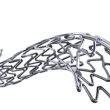Long 48mm Stent XIENCE Skypoint in the treatment of diffuse CAD Long coronary artery lesions often involve complex decision making since they can be treated either with a long stent or with shorter overlapping stents. Both in registries and meta-analysis, the overlapping technique has been associated to increased target vessel revascularization and increased radioscopy time,...
XIENCE SHORT DAPT | Ideal DAPT Period for Patients at High Risk of Bleeding
In patients at high risk of bleeding undergoing coronary stenting with a Xience stent, 1-to-3-month DAPT period resulted non-inferior to a 6-to-12-month period in terms of ischemic events, and this could be associated to a lower rate of major bleeding and lower stent thrombosis incidence. There is no longer an indication for conventional stents in...
EuroPCR 2021 | CASTLE: Orsiro vs Xience Guided by Intravascular Imaging
According to the CASTLE trial, the Orsino stent—a biodegradable, ultrathin, sirolimus-eluting stent—provides the same results at 12 months as Xience in angioplasty guided by intravascular imaging. This research was presented at the virtual EuroPCR 2021 Congress. Previous studies (BIOSTEMI and BIOFLOW V) showed that Orsiro was superior to Xience in reducing target-lesion revascularization. However, the reason behind this...
Xience Receives CE Mark for Short and Ultrashort DAPT Schemes
Dual antiplatelet therapy (DAPT) one month after angioplasty with Xience stent was approved in Europe for patients with high risk of bleeding. The CE Mark approval comes after studies Xience 28 and Xience 90 are published. Immediately after authorization, Abbot was fast to announce what they consider to be the shortest approved scheme with the most...
TCT 2020 | Xience in Favor of Short Dual Antiaggregation Therapy with High Bleeding Risk
Following with aspirin alone after a short period of dual antiaggregation therapy (DAPT), 1 to 3 months, did not increase ischemic events in patients receiving a Xience stent while significantly reducing bleeding. This study endorses the safety of short DAPT with contemporary drug eluting stents (DES) in patients presenting high bleeding risk. The XIENCE Short...
Theoretical Advantages Translated into Worst Clinical Outcomes: Synergy vs. Xience
New data from a real-world registry soon to be published in J Am Coll Cardiol Intv suggest that Synergy (a thin-strut everolimus-eluting stent with a biodegradable polymer) is associated with a higher risk of acute stent thrombosis when compared with classic Xience (a thicker-strut everolimus-eluting stent with a durable polymer). At 12 months, there was...
EuroPCR 2019 | Stent Firehawk Continues to Show Good Results at 2 Years vs. Xience
This device, an abluminal groove-filled biodegradable-polymer sirolimus-eluting stent manufactured in China, showed very similar efficacy and safety to the “gold standard” everolimus eluting Xience at 2-year follow up, according to the TARGET outcomes, presented yesterday at the EuroPCR 2019 and simultaneously published in J Am Coll Cardiol Intv. The device, which is manufactured in China...
DESSOLVE III: Xience vs. MiStent
The MiStent device is made of cobalt-chromium, with struts of up to 64 µm thick. It is coated with a completely absorbable polymer that contains a microcrystalline form of sirolimus that embeds directly into the vessel wall. The drug is eluted continuously for up to 9 months. This was a multicenter noninferiority study that randomized patients...
ABSORB III: More Events with Absorb Than With Xience at Two Years
The two year outcomes of ABSORB III, presented at the scientific sessions of the American College of Cardiology 2017, have shown the bioresorbable scaffold Absorb GT1 (BVS, Abbott Vascular) was associated with increased risk of target vessel failure, compared against the everolimus eluting stent Xience. At 25 months, target vessel failure occurred in 11%...
SYNERGY vs. XIENCE in Complex Real-World Patients
Courtesy of Dr. Guillermo Migliaro. Technological advancements in drug-eluting stents (DES) have shown significant improvement as regards the safety and efficacy of these devices. DES are considered to be the golden standard for the treatment of percutaneous coronary interventions. DES with permanent or durable polymers (DP) have been associated with local inflammatory reactions and...







